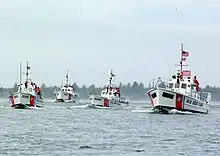52-foot Motor Lifeboat
The United States Coast Guard operates four 52-foot Motor Lifeboats (MLBs), which supplement its fleet of 227 47-foot Motor Lifeboats.[1] These vessels were built in the late 1950s and early 1960s, and displace 32 tons.[2] The four vessels are all stationed in the Pacific Northwest.
 The United States Coast Guard operates four 52 foot motor lifeboats in the Pacific Northwest. | |
| Class overview | |
|---|---|
| Name: | 52' MLB |
| Cost: | US$236,000 (1962) |
| Active: | 4 |
| General characteristics | |
| Displacement: | 32 tons |
| Length: | 52 feet (16 m) |
| Beam: | 14 feet 7 inches (4.45 m) |
| Draught: | 6 feet 11 inches (2.11 m) |
| Propulsion: | 2×GM 6-71, 170 hp (130 kW) |
| Speed: | 11 knots |
| Range: | 495 nautical miles (917 km) |
| Capacity: | 35 survivors + crew |
| Complement: | 5 |
| Sensors and processing systems: | Navigational radar |
Design and history
After World War II, reduced budgets meant the Coast Guard continued to use its two existing wooden 52' MLBs, also known as the Type F lifeboats, Invincible and Triumph.[3] By the late 1950s, the wooden MLBs were starting to wear out and the Coast Guard built a set of steel 52' MLBs at Curtis Bay Yard to replace them, specifically designed for the high surf conditions encountered along the Pacific Northwest coast. The steel 52' MLBs feature an aluminum superstructure and a hull divided into seven watertight compartments; because of their relatively high cost of US$250,000 (equivalent to $2,351,000 in 2019) each, only four were built.[4] After entering service, the steering/rudder system was modified by removing the rudder guard, shortening the bilge keels, installing twin rudders, and adding a hydraulic power assist to the steering.[4]

The Coast Guard bills the 52-foot MLBs as "virtually unsinkable", with self-righting and self-bailing capabilities and the ability to tow vessels as large as 750 long tons (760 t) in 30-foot (9.1 m) seas.[5] In comparison, the next-largest 47' MLB has a towing capacity of 150 long tons (150 t).[6] To increase their endurance and capabilities, the 52' MLB is equipped with a complete galley and a fire/salvage pump with 250 US gal/min (16 l/s) capacity.[4]
Vessels
The 52' MLBs are the only vessels of the Coast Guard less than 65 feet (20 m) in length to receive names,[7] keeping with the tradition established by their wooden predecessors.
| Boat | Hull no. | Builder | Laid down | Launched | Commissioned | Homeport | Status |
|---|---|---|---|---|---|---|---|
| Victory | 52312 | Curtis Bay Yard | November 29, 1956 | Yaquina Bay | In Service | ||
| Invincible II[lower-alpha 1] | 52313 | October 11, 1960 | Grays Harbor | In Service | |||
| Triumph II[lower-alpha 2] | 52314 | April 1, 1961 | Cape Disappointment | In Service | |||
| Intrepid | 52315 | October 11, 1961 | Coos Bay | In Service |
- Notes
- Named for wooden 52' MLB Invincible.
- Named for wooden 52' MLB Triumph.
References
- "America's Maritime Guardian". "Coast Guard Outlook". 2011. Retrieved 2013-01-27.
- "52-foot Motor Life Boat (MLB)" (PDF). United States Coast Guard. Archived from the original (PDF) on March 4, 2016. Retrieved 2012-11-10.
- "52-Foot Wooden-Hulled Motor Lifeboat" (PDF). U.S. Coast Guard History Program. Archived from the original (PDF) on September 21, 2015.
- "52-Foot Steel-Hulled Motor Lifeboat" (PDF). U.S. Coast Guard History Program. Archived from the original (PDF) on June 26, 2011.
- "Factsheet: Station Yaquina Bay" (PDF). United States Coast Guard District 13. Retrieved 24 October 2019.
- "Triumph tows disabled dragger through deep draft bar". Coast Guard News. December 10, 2017. Retrieved 24 October 2019.
- "Coast Guard member to receive national recognition for at sea rescue". Coast Guard News. August 10, 2017. Retrieved 24 October 2019.
Bibliography
- "Yaquina Bay LBS Gets New 52-Foot Lifeboat". Coast Guard Magazine. September 1956. pp. 32–33.
- Clark, Malcolm E. (September–October 1955). "The New 52-Foot Motor Lifeboat". U.S. Coast Guard Engineer's Digest (94): 25–26.
- Wilkinson, William D. (2009). American Coastal Rescue Craft: A Design History of Coastal Rescue Craft Used by the United States Life-Saving Service and the United States Coast Guard. Gainesville, Florida: University of Florida Press. doi:10.5744/florida/978813033341.001.0001. ISBN 9780813033341.
Individual boats
- "Victory, 1956: CG-52312" (PDF). United States Coast Guard. Archived from the original (PDF) on June 26, 2011.
- "Invincible II, 1960: CG-52313" (PDF). United States Coast Guard. Archived from the original (PDF) on September 27, 2012.
- "Triumph II, 1961: CG-52314" (PDF). United States Coast Guard. Archived from the original (PDF) on September 27, 2012.
- "Intrepid, 1963: CG-52315" (PDF). United States Coast Guard. Archived from the original (PDF) on September 27, 2012.
External links
| Wikimedia Commons has media related to USCG steel-hulled 52-foot Motor Lifeboat. |
- Lawford, Clive. "52ft Motor Lifeboats". 44ft Motor Lifeboats.
- "U. S. Coast Guard Yard, Baltimore MD". Shipbuilding History. May 21, 2011.
- Dring, Tim R. "Motor Lifeboat (52ft.)". U.S. Life-Saving Service and U.S. Coast Guard Rescue Craft History.